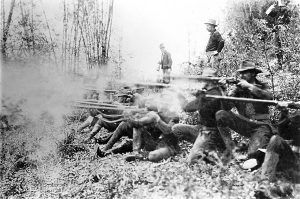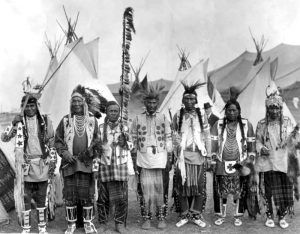When news of the Whitman Massacre reached the provisional Oregon Territorial capitol at Oregon City in early December 1847, immediate steps to raise a volunteer regiment began. Organizing a force of about 600, Cornelius Gilliam, an Oregon pioneer and former military officer in the U.S. Army, was appointed colonel to lead the Oregon Volunteers and prosecute the Cayuse.
The company left about the first week of January 1848, followed the trail to a point above the Cascades, and proceeded to the Dalles. The soldiers believed that the Cayuse, Walla Walla, Nez Perce, Yakama, and other tribes joined forces against the whites, and a policy was adopted to fight any Indians they found. In actuality, the Cayuse had attempted to get many other tribes to join them, but most were hesitant, and the Nez Perce worked actively against them. By February 12th, a total of 537 officers and men had arrived at The Dalles. Four days later, Colonel Cornelius Gilliam left 20 men to guard Fort Lee (later Fort Dalles) and began his march.
The troops first encountered Indians on January 30th on the Des Chutes River. The Indians were driven off, and the casualties on each side were few. However, the “victory” had a positive effect on the soldiers as they continued further into the interior of the Indian country.
Two more battles would occur within the next several months — the Battle of Sand Hollows on February 24th and the Battle at the Touchet River on March 14th.
By May 1848, the Oregon Rifles were led by Colonel Henry A.G. Lee. On May 17th, Lee, along with Captain Philip F. Thompson and about 400 troops, continued the pursuit of the Whitman murderers. In an attempt to find them, Lee offered the Nez Perce several hundred dollars worth of merchandise if they would assist in the capture. As the various tribes began to see the army’s strength and determination, many of the tribes who had been sympathetic to the Cayuse began to distance themselves from them. To show their changed attitude, the Walla Walla caught and hanged one of the murderers and sent word that they were on the trail of another. The Cayuse soon left the area, hiding in the Blue Mountains.
Although the murderers had not yet been caught, the hostilities died down, and by June, the Army decided to abandon the campaign for the season. The troops then began their journey home, arriving at Oregon City about June 20, 1848, where they were promptly mustered out of service. Though the campaign had ended, the Cayuse War continued sporadically for the next several years. They continued to strike at white settlers before again retreating into the Blue Mountains.
Compiled by Kathy Alexander, updated April 2021.
Also See:
The Cayuse War – Revenge for the Measles
Frontier Skirmishes between the Pioneers & the Indians
Indian Conflicts of Washington


